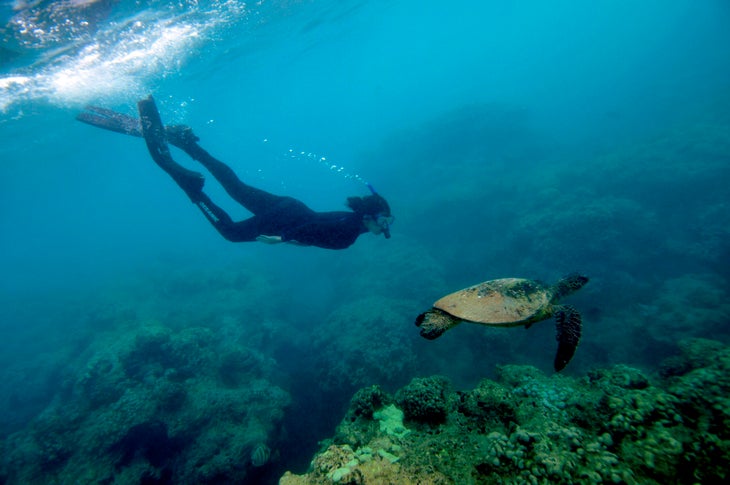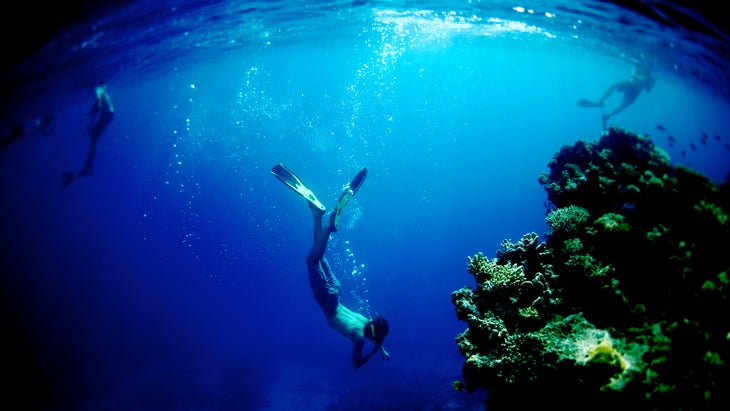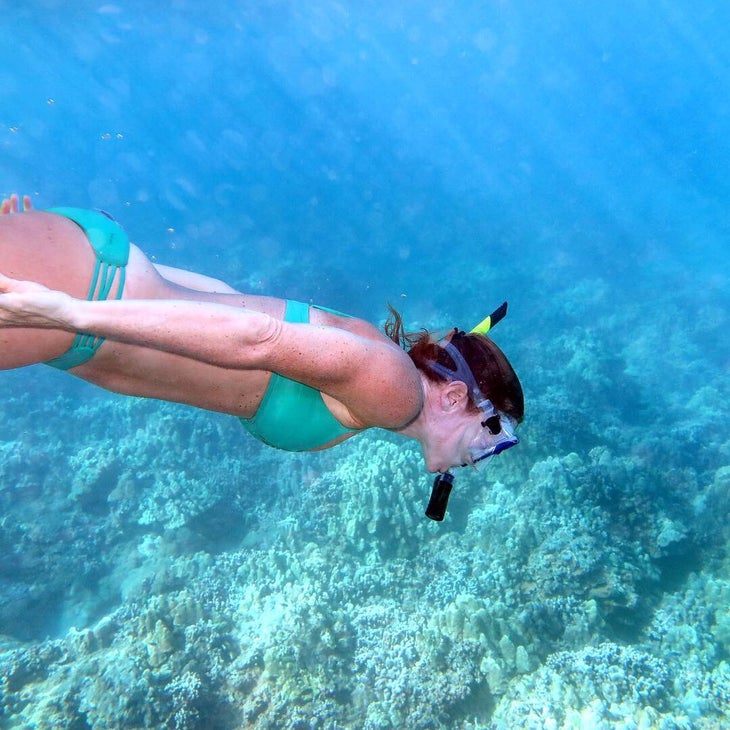Hawaii’s tumbling waterfalls, craggy lava fields, and palm-shaded beaches are undeniably enchanting. But the islands’ true beauty lies beneath the surface of the sea. When I slip on fins, a mask, and snorkel and dive into the ocean, another world reveals itself: green turtles munching sea grass, neon-hued parrot fish and wrasse darting between colorful corals, and during certain months, a symphony of humpback whales.
The captivation of seeing sea creatures up close explains why snorkeling is so popular. According to the Hawaii Ocean Safety Team, a nonprofit dedicated to making the state’s waters safer and cleaner, approximately 3 million people snorkel in Hawaiian waters each year. Most people won’t be surprised to learn how many people enjoy such an accessible, wonderful activity—but what’s shocking is how dangerous it can be and the consistent number of snorkeling fatalities. According to the Hawaii State Department of Health, drowning is the , far outpacing the national average. Around 45 tourists drowned in the ocean each year in Hawaii , and snorkeling was the number one contributor.
This year has proved especially deadly. In March, a 43-year-old visitor from California at unguarded Larsen’s Beach. And Oahu saw two snorkel-related tourist deaths the first week of February: a 64-year-old woman on the North Shore and a who was part of a kayak tour.
While these incidents were terrible, they also didn’t shock me. I live part time in Maui and regularly see panicked snorkelers. In February, I watched an older gentleman crawl out of the water onto the beach as he was pounded by shore break in his snorkel gear. Later that month, I witnessed a young woman struggle to remove her mask after it had filled with water. Despite the dangers, many snorkelers appear to lack safety training or an understanding of their gear—I regularly observe people wearing fins backwards and snorkels upside down.

Underestimating the Skills Required to Snorkel
Some visitors mistakenly think a snorkel is a flotation device, said Andy McComb, founder of Redline Rafting, a tour operator in Maui that runs snorkel excursions. He said his team is asked almost daily: “Do I need to know how to swim in order to snorkel?” Swimming is challenging enough for some people. Add a claustrophobic mask, a straw-like snorkel, fins that can weigh you down, plus waves and strong currents, can lead to a casual activity quickly turning into a high-intensity workout.
“When people come to Hawaii, they see beauty, not danger,” said Jason Bitzer, a former Honolulu Ocean Safety member who spent six years lifeguarding at . “Visitors think snorkelling is a controlled activity, like zip-lining. The ocean is in control.”
Even in the calm, flat waters of Hanauma Bay, water can enter through the top of the snorkel. “People panic and instead of pulling the snorkel out of their mouth to spit out the water, they start to suck it in and choke,” said Shayne Enright, a spokesperson for Honolulu Ocean Safety. “That’s how a drowning can start even in harmless looking ocean conditions.”
A common misconception is that snorkeling is effortless and relaxing. It can be for some people. But for those new to the activity, it can be overwhelming and exhausting, too. “You need to have coordination, some fitness, and an awareness of your surroundings, even if you’re in three feet of flat water,” said Enright. “Just like riding a bike, it takes practice to get comfortable.”

Why Do Experienced Snorkelers Drown?
It’s easy to blame inexperience on the unusually high number of deaths, but many fatalities have involved experienced swimmers and snorkelers, like Ray Johnson. In February 2022, Johnson, then 64, took his fifth vacation to Hawaii with his wife Patti and four friends. The Michigan couple had snorkeled the waters of Hawaii many times before, Patti told me. “Ray was an incredible snorkeler; it’s what he loved to do,” she said. “We planned vacations around snorkeling. He’d snorkel the lakes in Michigan and always kept his fins and snorkel in the car.”
On February 25, two days after their arrival, Ray and some friends went snorkeling off Wailea Beach in Maui, which fronted their resort, the Fairmont Kea Lani. Patti had taken a walk along the paved path that overlooks the beach. “I looked out and waved and then realized it looked like people were helping him,” she recalled. “I assumed he stepped on a lava rock.” She rushed down to the beach, but by then she said he was on his back and being pulled out of the water.
Someone called 911, but medical professionals weren’t able to resuscitate him. The autopsy report deemed Ray’s death an accidental drowning, which Patti said she doesn’t believe. The friends who had been snorkeling with Ray told her at one point, he said, “you gotta help me, I’m having trouble breathing.” That’s when they decided to head to shore, she said. “I don’t think you’re having a conversation if you’re drowning,” she rationalized.
The Johnson family believes the real cause of Ray’s death was a lesser-known medical condition called rapid onset pulmonary edema, or ROPE, which causes fluid build up in the lungs. In 2024, Patti filed a lawsuit against the Hawai‘i Tourism Authority, Hawaii Visitors and Convention Bureau, and the Fairmont Kea Lani, where Ray rented the gear, alleging that Hawaii travel entities failed to educate the public on this “important public health concern,” according to the complaint filed in the Circuit Court of the First Circuit in the State of Hawaii. Patti’s Oahu-based lawyer, Jay Stuemke, told me the case is still in the discovery phase, and trial is currently set for November. The Hawaiian Tourism Authority, Hawaii Visitors and Convention Bureau and Fairmont Kea Lani declined to comment on the lawsuit.

What Is ROPE and How Does it Affect Snorkelers?
Years of data from the Hawaii Department of Health revealed that many snorkel-related fatalities occurred in mild ocean conditions and were not accompanied by signs of distress. In October 2017, the state established a Snorkel Safety Sub-Committee to investigate the unusual circumstances. A two-year conducted by the sub-committee and funded by the Hawaii Tourism Authority tested 50 different snorkels, reviewed medical examiner reports and case studies, and conducted a survey of 131 snorkelers at Hanauma Bay.
The study was the first to link ROPE to snorkeling. released in 2021 concluded that rapid onset pulmonary edema in snorkelers may be as common, or more so, than the accidental inhalation of water, which typically causes someone to react in distress. When snorkeling, we breathe against more resistance than we typically would, explained Dr. MeiLan Han, Chief of the Division of Pulmonary and Critical Care at the University of Michigan Health. “When the body tries to inhale but is unable to do so or it’s hard to do so, it creates increased negative pressure within lungs,” she said. “This encourages fluid to cross over from the blood into the lungs.” When this occurs, the person can lose too much oxygen and become unconscious. “ROPE associated with snorkeling certainly can be fatal,” said Dr. Han, who noted that there is very little literature on this topic.
The snorkel safety study suggested that preexisting medical conditions, increased exertion, exposure to high altitudes, and the degree of the snorkel’s resistance to inhalation may increase risk of ROPE while snorkeling. It also suspected that prolonged air travel might be a factor given the majority of travelers have flown at least five hours to reach Hawaii. However, data was not conclusive and the sub-committee recommended further research of this hypothesis. The study also recommended developing a statewide public education program to address snorkeling safety.
According to a spokesperson for the Hawaiʻi Visitors and Convention Bureau, only general ocean safety posters are in the island airports. And have been created to warn against everything from dangerous shorebreaks to jellyfish, but very few are specific to snorkel safety. Because Hanauma Bay State Park is a snorkel haven, visitors are required to watch a seven-minute that warns: “Snorkeling is a strenuous activity that requires good physical conditions and skillful practice. It is critical to your safety that you have strong swimming abilities before entering the ocean.”
The state’s has a dedicated with that include a footnote about how causes of snorkel-related drownings, including air travel, are currently under investigation. Patti Johnson said she and her husband had never seen this brochure, nor had they been warned of any of these potential risks while snorkeling in Hawaii, particularly the concern around flying. She said she has since heard of snorkelers being warned to wait a few days after air travel in Cancun, Curacao, and Thailand. Patti now distributes business cards with warnings about air travel and snorkel-related ROPE to friends and sporting goods stores. “My main goal in life is to educate people and hopefully to get Hawaii to start educating people,” she said.
Should You Be Wary of Full-Face Masks?
Generally speaking, you want a simpler snorkel design that is easy to breathe from, said Dr. Han. “You don’t want to be pulling against a lot of resistance,” she said. Of the 50 masks and snorkels tested in the snorkel safety study, only four were , which allow the user to breathe through their nose and mouth and typically feature a tube at the forehead.
The study concluded that full-face snorkelling masks had no inherent advantage or disadvantage in terms of resistance, however they did have drawbacks. Users cannot spit out the mouthpieces, nor are they able to dive beneath the surface safely. They can’t be removed easily in an emergency. Water can’t be cleared from the tube, often located at the top of the mask, by blowing sharply. And the study found valve malfunction could lead to serious breathing impairments. I personally have found full-face masks, even those with quick-release mechanisms, very hard to take off and feel that you should always choose the safer, rather than the more comfortable, gear option.
Colin Yamamoto, a sub-committee member and former battalion chief of ocean safety for the Maui Department of Fire and Public Safety, said he conducted his own research on full-face masks versus traditional face masks and found the former to be far riskier. “I’m not a scientist,” he said. “But my theory is that you are breathing in higher levels of carbon dioxide with the full-face mask. That coupled with low oxygen levels is problematic if you are older or have pre-existing medical conditions.” A small, 10-person conducted by Duke University in 2021 was inconclusive about whether full-face masks were responsible for more snorkel drownings, but it did raise safety concerns around the lack of regulation and control of these masks.
The includes a section about the pros and cons of using a full-face mask, and links to a from Dr. Monty Downs, President of the Kauai Lifeguard Association in which he opined: “Don’t use full-face snorkel masks unless you are an expert who’s had a lot of training and experience with them.” Many in Hawaii have independently banned the use of full-face mask snorkels and tourism boards, such as the one for , now warn visitors of the risks of full-face mask snorkels.

Snorkel Safety 101
The following is a list of tips I curated from recommendations listed on the Hawaii Department of Health ocean safety page, Honolulu Ocean Safety members, and snorkel tour operators.
- Check ocean conditions and only snorkel at guarded beaches. “The chance of a rescue and resuscitation is much higher at a guarded beach,” said Enright, of Honolulu Safety.
- Never go alone. Always have a buddy. Inexperienced snorkelers should consider booking with a tour operator.
- Rest a day or two after flying. “I never suggest anyone go straight from the plane to doing any activity, whether snorkeling or surfing,” said Enright. “Many visitors come here dehydrated and need to acclimate to the different climate. Give your body time to regulate.”
- Test your gear on dry land or even in a pool before jumping into the ocean. Your fins and mask should have a snug, yet comfortable, fit. Practice breathing through the snorkel. Know how to clear water from your snorkel and what to do if your mask leaks or fogs. Make sure you can scissor kick with your fins while swimming. A doggie paddle or frog kick won’t cut it.
- Don’t wear your fins on the beach or boat. Walk into the water first, get past the shore break, then put them on. Similarly, take them off before you exit the water.
- Go slow, breathe slowly, and keep your heart rate low. Don’t overexert yourself.
Jen Murphy is a regular contributor to �����ԹϺ��� and a snorkel fanatic. She lives part time in Maui where she snorkels any chance she gets. In her 20s, she worked a short stint as a snorkel assistant aboard a catamaran, where she regularly fielded questions, such as, “do I really need to get my face wet to snorkel?”



